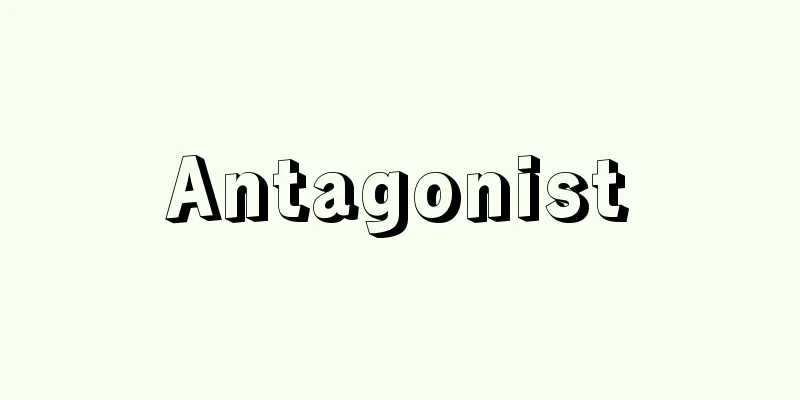Antagonist

|
One of the roles in Kabuki, broadly referring to the role of a villain. It is the opposite of tachiyaku, which means the role of a good man. There are various types and names depending on the play and the nature of the role. For example, the mastermind behind the rebellion, such as Nikki in "Sendaihagi" and Daizen in "Kinkakuji", is the highest-ranking villain and is called jitsuaku (or tategataki). Similarly, high-ranking villains, such as Shihei in "Sugawara" and Iruka in "Imoseyama", who have indigo circles on their faces and exert powers like a demon king, are called kugeaku, meaning villains of the nobility. In addition, handsome villains such as Yoemon from "Kasane" and Iemon from "Yotsuya Kaidan" are called iroaku (sexy villains), cheap villains such as Yakushiji from "Chushingura" are called hiragataki or hagataki (common villains), and villains with strong clownish elements such as Bannai are called handogataki (half-path villains). Among the common villains and half-path villains, some are called ojigataki (uncle villains) such as Oe Onitsura from "Sendaihagi" and Hajinohyoe from "Sugawara", and tedaigataki (manager villains) (or storekeeper villains) such as Zenroku from "Imose no Kadomatsu" and Chokuro from "Hokkaibo". The term "villain" originally referred to an actor who specialized in playing villains, and was also called "akuninkata." Although it has become a common term, today in plays, movies, and television, the term is often used to refer to "villain." [Toshiaki Matsui] Source: Shogakukan Encyclopedia Nipponica About Encyclopedia Nipponica Information | Legend |
|
歌舞伎(かぶき)の役柄の一つで、広く悪人の役をいう。善人の男の役を意味する立役(たちやく)に対するもの。演目や役の性質により、いろいろな種類と名称がある。たとえば『先代萩(せんだいはぎ)』の仁木(にっき)、『金閣寺(きんかくじ)』の大膳(だいぜん)など、謀反の元凶は最高級の敵役で、実悪(じつあく)(または立敵(たてがたき))とよばれる。同じく位の重い敵役で、『菅原(すがわら)』の時平(しへい)、『妹背山(いもせやま)』の入鹿(いるか)など、顔に藍隈(あいぐま)を施し、魔王のような力を発揮する役は、公卿(くぎょう)の悪人の意味で公家悪(くげあく)という。ほか『累(かさね)』の与右衛門(よえもん)や『四谷怪談』の伊右衛門のような美男の悪人を色悪(いろあく)、『忠臣蔵』の薬師寺(やくしじ)のように安手な敵役を平敵(ひらがたき)または端敵(はがたき)、同じく伴内(ばんない)のように道化の要素の濃い敵役を半道敵(はんどうがたき)とよび、平敵・半道敵のなかには、『先代萩』の大江鬼貫(おにつら)や『菅原』の土師兵衛(はじのひょうえ)などを伯父敵(おじがたき)、『妹背門松(いもせのかどまつ)』の善六や『法界坊』の長九郎などを手代敵(てだいがたき)(または番頭敵)というように、役の年齢、身分からきた呼称もある。なお敵役というのは、本来悪人を専門とする俳優のことでもあり、悪人方ともよばれた。また一般語にもなっているが、今日の演劇、映画、テレビなどでは「悪役(あくやく)」ということが多い。 [松井俊諭] 出典 小学館 日本大百科全書(ニッポニカ)日本大百科全書(ニッポニカ)について 情報 | 凡例 |
Recommend
Coast Atlas [Mountain Range] - Coast Atlas
The Atlas Mountains are a series of small, low mo...
Amakusa Shiro
...A general term for plays that have Christianit...
Oiraku - Oiraku
...First of all, this family includes the largest...
Misjudgment - Gohan
〘 noun 〙 A wrong judgment. A miscarriage of justic...
Shallot - échalot (English spelling) French
A perennial plant of the lily family (APG classif...
Bulbul (Brown-eared bulbul) - bulbul (English spelling)
A general term for birds of the passerine order Py...
Satomi clan - Satomiuji
Sengoku daimyo of the Boso region. Seiwa Genji. I...
Active Homing
⇒ Active radar homing Source: About Shogakukan Dig...
Taishan Fukun
An ancient name for the god of Mount Taishan in D...
Whig
…The origin of the modern political party is ofte...
Bretton Woods System
The Bretton Woods Agreements, also known as the Br...
Almond, GA - Almond
…The American political scientist D. Easton was t...
Echigo Jofu
Among the hemp fabrics produced mainly in Ojiya, ...
Synthetic theory
…During this time, de Vries's Theory of Mutat...
Ezochi Development Theory - Ezochikai Hatsuron
...The turning point that changed this situation ...









